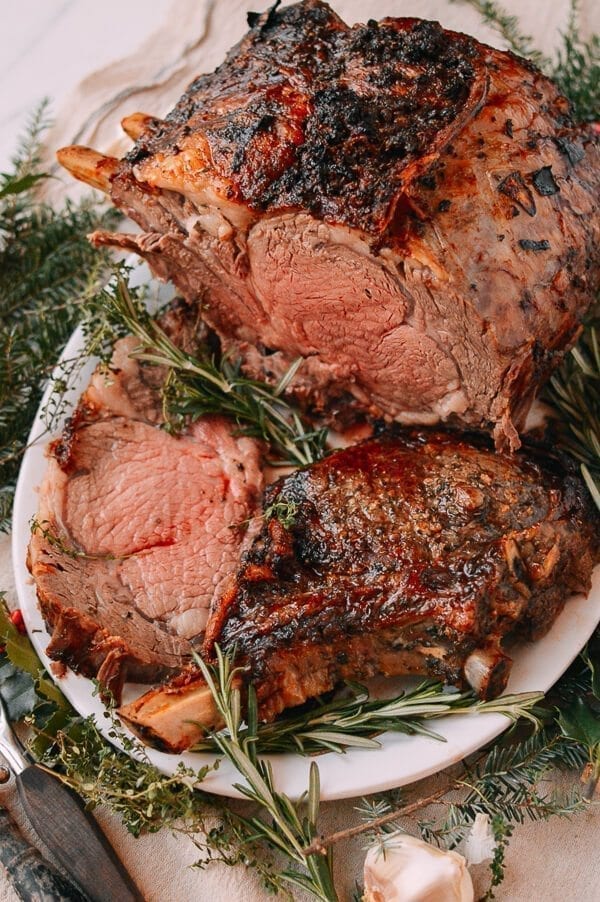The Perfect Prime Rib Roast Family Recipe
5.0
(38)
Your folders
Your folders
Prep Time: 720 minutes
Cook Time: 180 minutes
Total: 900 minutes
Servings: 1
Author : Bill

Ingredients
Export 6 ingredients for grocery delivery
Instructions
Step 1
The butcher knows how much fat to leave on the roast, so no additional trimming is needed. Your prime rib roast should have a nice layer of fat on top, so it will baste itself. Before marinating, give your prime rib roast a quick rinse with cold water, and pat it dry with paper towels.
Step 2
Place a flat roasting rack inside a roasting pan large enough to fit your roast, and spread the onions on top of the rack. It’s ok if you don’t have a roasting rack--resting the roast directly on the onions works also. Place the roast in the pan.
Step 3
Mix the salt, pepper, garlic, herbs and olive oil in a bowl until well-combined. Use your hands to rub the roast all over with the marinade mixture, coating the surface evenly.
Step 4
Use plastic wrap to cover the roast, and let it marinate overnight (at least 8 hours) in the refrigerator. We don’t expect the flavors to penetrate the roast completely, but it will work its way into the fatty collar portion of the roast. Skipping this step makes a big difference in flavor––we’ve had some mediocre roasts due to a lack of marinating time, so take my word for it!
Step 5
Take the roast out of the refrigerator at least 2 hours before cooking time to allow the roast to come up to room temperature. It's best to take it out in the morning and leave it out 6 to 8 hours especially if you have a bone-in roast. Preheat the oven to 450 degrees F, and place your roast on a lower oven rack. For bone -in roasts, you may want to put the roast at the bottom of the oven for the first hour. Placing the oven rack too high up will cause your roast to brown too quickly and burn!
Step 6
After 30 minutes in the oven, add a ½ cup of water to the bottom of the roasting pan. The key is to allow the onions to brown and caramelize while roasting, but not to burn and smoke in the fat.
Step 7
Cook the roast for another 30 minutes, until it begins to brown. If your oven heats unevenly, turn your roast 180 degrees. If there is more fat on one side that has not browned yet, make sure you position that side of the prime rib roast toward the inside of the oven. Use your own judgement on this one!
Step 8
Once the prime rib roast is browned on the outside (1 hour total should do it, but times may vary depending on your oven), lower the heat to 350 degrees F. Continue roasting the prime rib for another 90 to 120 minutes. Baste the roast every 30 minutes if desired, and add hot water ½ cup at a time if the roasting pan does dry up.
Step 9
If the top of the roast starts to char, put a small piece of foil to lightly cover the top, leaving the sides exposed. Again, turn the roast 180 degrees if needed for even roasting.
Step 10
A general rule I use to approximate roasting time is a total of 15 minutes per pound, so for this 12 pound roast, the total roasting time should be 180 minutes. With temperature changes, that means roasting at at 450 degrees F for 60 minutes followed by 120 minutes at 350 degrees F. That said, these times are approximate--using a meat thermometer is a must. You don’t want to overcook it! We always cook for medium rare, so the time will be closer to 90 minutes, or when the prime rib roast reaches an internal temperature of 125 degrees F. This gives you two more well-done Prime Rib end cuts and a couple of medium pieces mixed in with the medium rare cuts. If you like it rare, then roast for less time, taking the roast out of the oven when the internal temperature reaches 120 degrees F. If your like it super-rare, then 115 degrees F may be for you. Just remember that the meat thermometer is your guide and that the roast will continue to cook a bit while it rests on the kitchen counter!
Step 11
When ready, set your prime rib on a cutting board or serving platter, and lightly cover it with a piece of aluminum foil to rest for 15 to 20 minutes.
Step 12
While the prime rib is resting, pour the pan juices through a fine mesh strainer into a fat separator. If there is not enough liquid, add a ½ cup of water to the hot pan, and stir lightly. Pour the juices from the fat separator into a small pot or saute pan and set aside. Warm up the au jus, and serve alongside the prime rib. You can further dilute it with some hot water to taste if it’s too salty. If it suits your fancy, you can also serve some horseradish alongside.